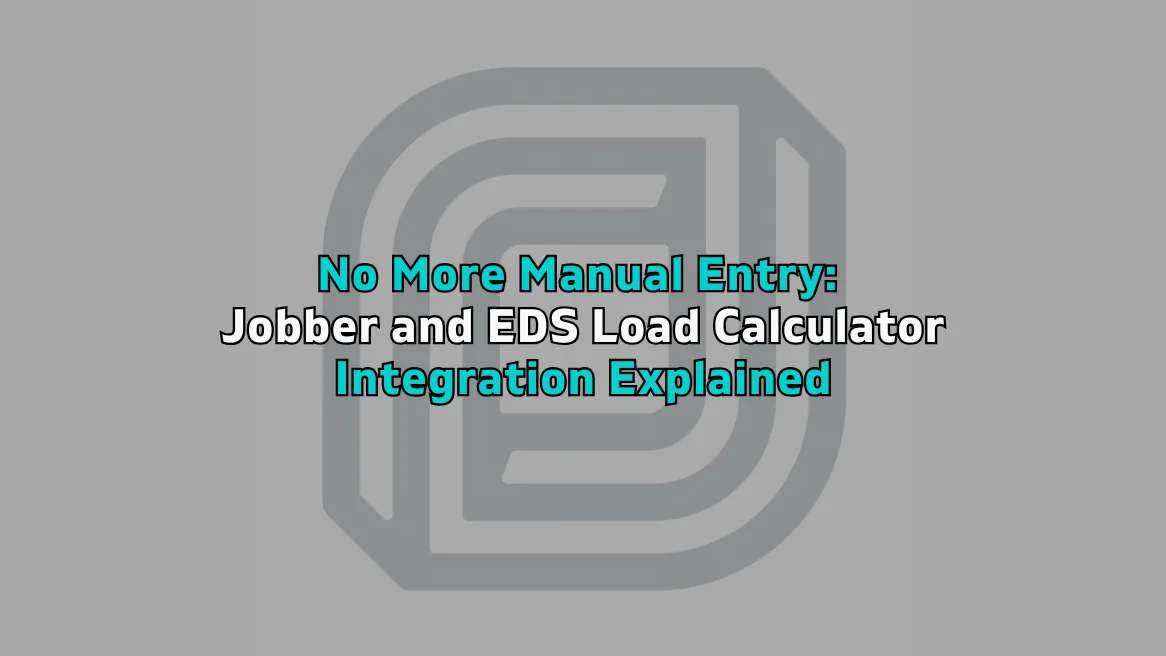No More Manual Entry: Jobber and EDS Load Calculator Integration Explained
In HVAC work, precision is key. The details may break a project, whether it involves creating best HVAC load calculation software reports or dealing with customers. However, most HVAC companies continue to lose precious time on manual data input, logging findings in an HVAC load calculator to a CRM, manually entering job information, or sending reports via email.
Not only does this promote the possibility of human error, but it also delays the project’s delivery and aggravates the clients.
The solution? Integrating your load computing devices with your management system. And this is what will happen when you combine the EDS Load Calculator with Jobber. With strong workflow automation, fewer errors, and an enhanced customer experience, businesses can automate jobbers using powerful jobber integrations.
Why HVAC Businesses Need Reliable Load Calculation Software
The reason why HVAC load calculation software is so central to HVAC success can be explained before delving into the integration. There are also tools such as the EDS Load Calculator, which removes the guesswork in system design by giving accurate information on heating and cooling needs.
Benefits of Using an HVAC Load Calculator
- Proper sizing of the system: Not only undersizing or oversizing HVAC equipment.
- Energy efficiency: With proper load calculations, the systems will not be energy-wasting.
- Regulatory compliance: Conforming with industry standards and local building codes.
- Customer satisfaction: A system of good size means comfort and lower utility bills.
The issue lies in the fact that these precise results must be manually re-keyed into different systems, such as CRM systems or job scheduling systems. It is where Jobber CRM integrations with EDS come in really big.
Read: Supercharge Your HVAC Business with HVAC Load Calculator Software
Jobber: A Powerful CRM and Workflow Platform for HVAC
Jobber has gained rapid momentum as one of the most popular solutions for small- to mid-sized service companies. It eliminates bureaucratic headaches that typically burden HVAC contractors, offering features that include customer management, scheduling, invoicing, and payment processing.
Jobber HVAC Businesses: Key Features.
- Client Management: Have all customer information in a single location.
- Job Scheduling and Dispatching: Schedule technicians efficiently and effectively.
- Invoicing and Payments Under Billing: Automate the payment to accelerate the flow of money.
- Reporting Tools: See the performance and profitability.
Jobber is in itself an operation streamliner. However, it is a one-stop shop when augmented with jobber CRM integrations, such as the EDS Load Calculator.
Problem with Manual Entry Between Tools
Consider such a workflow as follows:
- The EDS Load Calculator is used by technicians to perform accurate HVAC load calculations.
- Output is exported to a spreadsheet or PDF.
- The office staff copies or attaches that file to Jobber.
- Mistakes infiltrate, or records are lost.
Needless to say, the time and risk associated with manual entry is evident. It consumes time in productivity and preconditions expensive errors. Jobber automation helps to eradicate these inefficiencies.
Read: Why Every HVAC Contractor Benefits From a Load Calculator
How the EDS + Jobber Integration Works
The EDS HVAC Load Calculator & Jobber CRM integration will help to remove the manual data entry that is time-consuming and prone to errors.
The two platforms are also able to send information directly, ensuring that all jobs start with the correct data for the HVAC load calculation and proceed smoothly through scheduling, invoicing, and customer communication. The following provides a more detailed examination of how it works in practice.
1. Input and Calculation in EDS
The EDS Load Calculator is the beginning. Project information, including square footage, insulation values, windows, and climate data, is entered by a technician or office staff member. The software then performs an accurate calculation of HVAC loads, producing a result that informs the correct sizing of equipment and system design.
Key points at this stage:
- Calculations of loads are accurate to industry standards.
- Reporting is done in real-time digitally.
- The information is prepared to be integrated with Jobber without any additional measures.
2. Automatic Data Sync with Jobber
Once this is done, the integration transfers the information into Jobber. One does not have to download a PDF or manually enter numbers into fields. Rather, Jobber gets automatic results.
Such advantages of this sync are:
- Eliminating the repetition of the data.
- Ensuring that customer profiles in Jobber are attached to the correct calculation outcomes.
- Minimizing the chances of lost files or records that do not match.
3. Job Creation and Task Assignment
The results of the calculations are directly related to existing or new jobs through Jobber CRM integrations. For example:
- Jobber is automatically created with a new installation project, and the load calculation is attached.
- At the office level, technician assignments can be made based on availability and competency.
- The Jobber mobile app provides technicians with real-time job information, and the results of calculations related to loads can be obtained at the location.
This is done to ensure that jobs are always based on reliable data from the HVAC load calculator.
4. Customer Communication and Estimates
Since Jobber facilitates communication with clients, it is easy to stay on top of them due to the integration. After the calculation of the load is in sync:
- Quotations may be produced immediately and with calculation data to back it.
- The customers are given professional estimates emphasizing the benefits of energy efficiency and comfort.
- Automatically, updates are sent when the project milestones are achieved.
It is this level of transparency that makes it possible to improve trust and customer experience.
5. Ongoing Updates and Reporting
It is not only one-way integration. Jobber records are automatically refreshed when updates are made, such as revisions of designs or the addition of extra notes.
Key outcomes:
- Teams are the ones that work with up-to-date information.
- The management has the option to get full reports that have technical data provided by EDS and operational data provided by Jobber.
- The workflow is not interrupted by to-and-fro emails or the uploading of documents.
6. End-to-End Workflow Automation
When used together with EDS HVAC load calculator software and Jobber scheduling and CRM, HVAC businesses gain access to a truly end-to-end workflow:
- Design Accuracy → Load Calculations are accurate and dependable.
- Data Transfer → Results are transferred directly into Jobber.
- Job Management: Job is created, allocated, and monitored automatically.
- Customer Engagement → The Clients are provided with timely updates.
- Reporting → Business owners enjoy complete transparency of the technical and operational performance.
This integration is transforming the mode of operation in HVAC firms, making projects simpler, time-saving, and more effective compared to manual entry.
Real-World Benefits of Jobber + EDS Integration
1. Accuracy and Error Reduction
When it is automated, there is no possibility of entering incorrect values or selecting the wrong report. Calculation of loads is the same across platforms, which makes technicians secure and customers comfortable.
2. Faster Job Turnaround
Office personnel and technicians do not need to wait till manual entry of data. Jobs are created immediately, schedules are expedited, and customers are notified promptly.
3. Administrative Efficiency
Office personnel save hours of work per week by eliminating redundant entry procedures. Rather, they will be able to concentrate on more important things such as customer service or business development.
4. Better Customer Experience
Customers enjoy the benefits of quicker quotations, accurate system designs, and prompt communication. Trust and retention are enhanced by the professionalism of a smooth workflow.
5. Scalability for Growing Teams
As your HVAC business grows larger, it becomes increasingly unmanageable to enter data manually. The automation process makes sure that the workflows are efficient, be it in five projects/week or fifty.
Overcoming Challenges in CRM Integrations
Naturally, combining two platforms presents challenges. Some businesses may face:
- Mapping data problems: It is important to ensure that fields in the hvac load calculator are mapped to fields in Jobber.
- Change management: Educating personnel to incorporate automated workflows rather than relying on manual habits.
- Varnishing of workflows: This ensures that the integration is tailored to suit your specific business processes.
Alternatively, luckily, with the right arrangement, Jobber and EDS are compatible and these obstacles are easy to get through.
Future of HVAC Workflows: Smarter, AI-Driven Integrations
Jobber + EDS integration is not the end. As AI advances, HVAC companies will have even more intelligent automation that will come in the future:
- Recommendations of a predictive system based on former HVAC load calculation software data.
- Artificial intelligence scheduling to find the most suitable technician to do the job.
- Customer communication tools that service needs before the customer makes a call.
- By applying jobber integrations early, businesses will have an advantage in exploiting innovations as they emerge.
Conclusion
At Energy Design Systems (EDS), we realize that HVAC contractors do not have time to waste in manual repetitive jobs. This is why our HVAC load calculator becomes part of Jobber CRM integrations that prevent duplication of entries and make sure that the workflow is correct, swift and customer-oriented.
By combining EDS with Jobber, you will have:
- Data transfer between platforms is automated.
- Perfectly accurate HVAC load calculation software outputs are directly related to jobs.
- Scalable business processes that expand with you.
We are convinced that HVAC professionals need the means to work smarter, but not harder. And, in the case that you are willing to eliminate manual input and start living in the flow of automation, our team at EDS is committed to helping you transition from traditional HVAC operations to an improved one.


